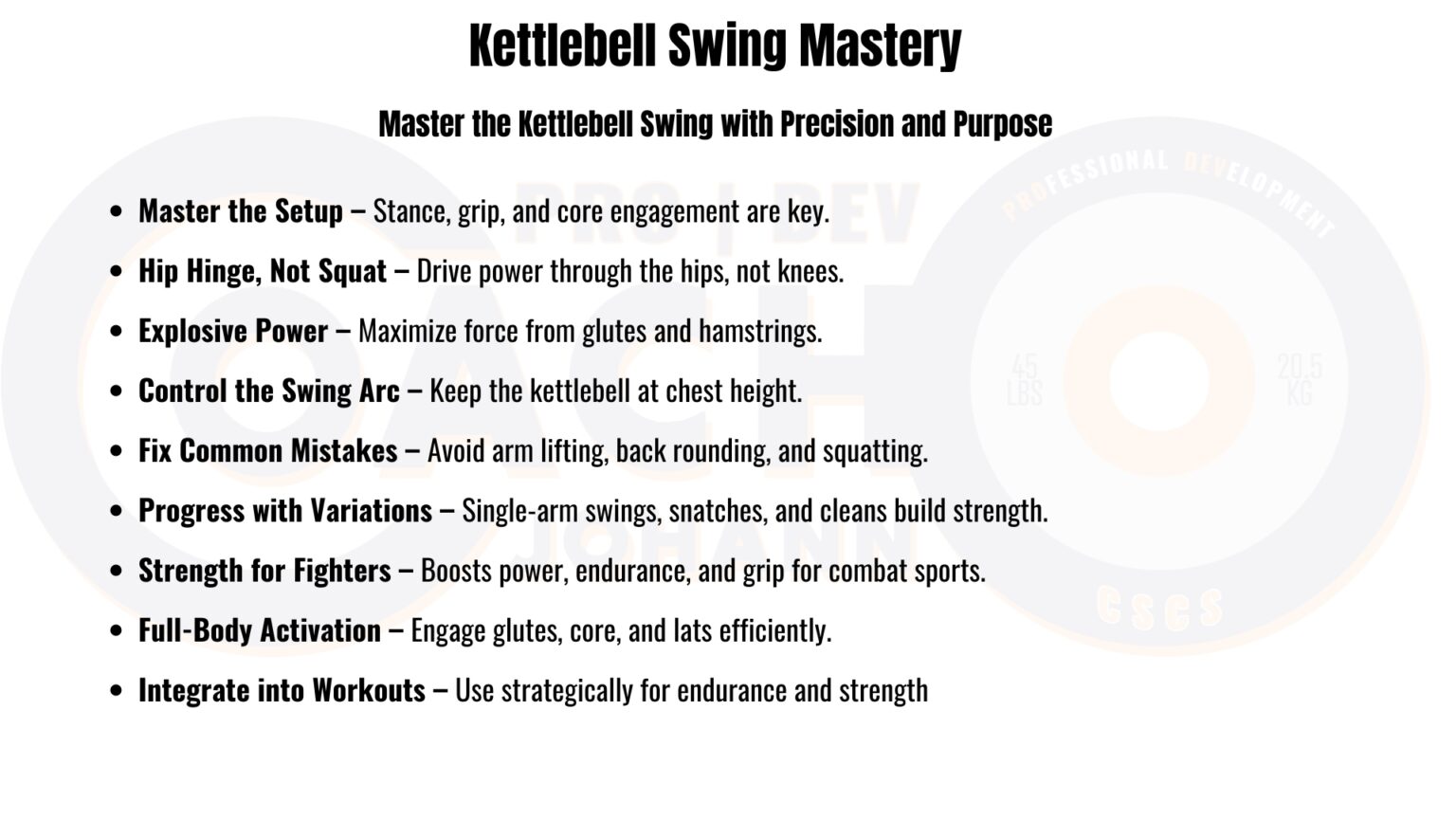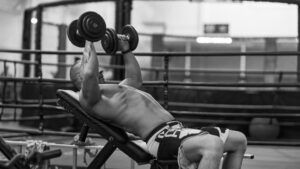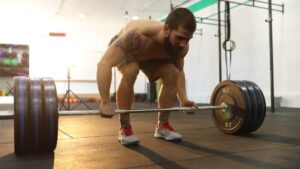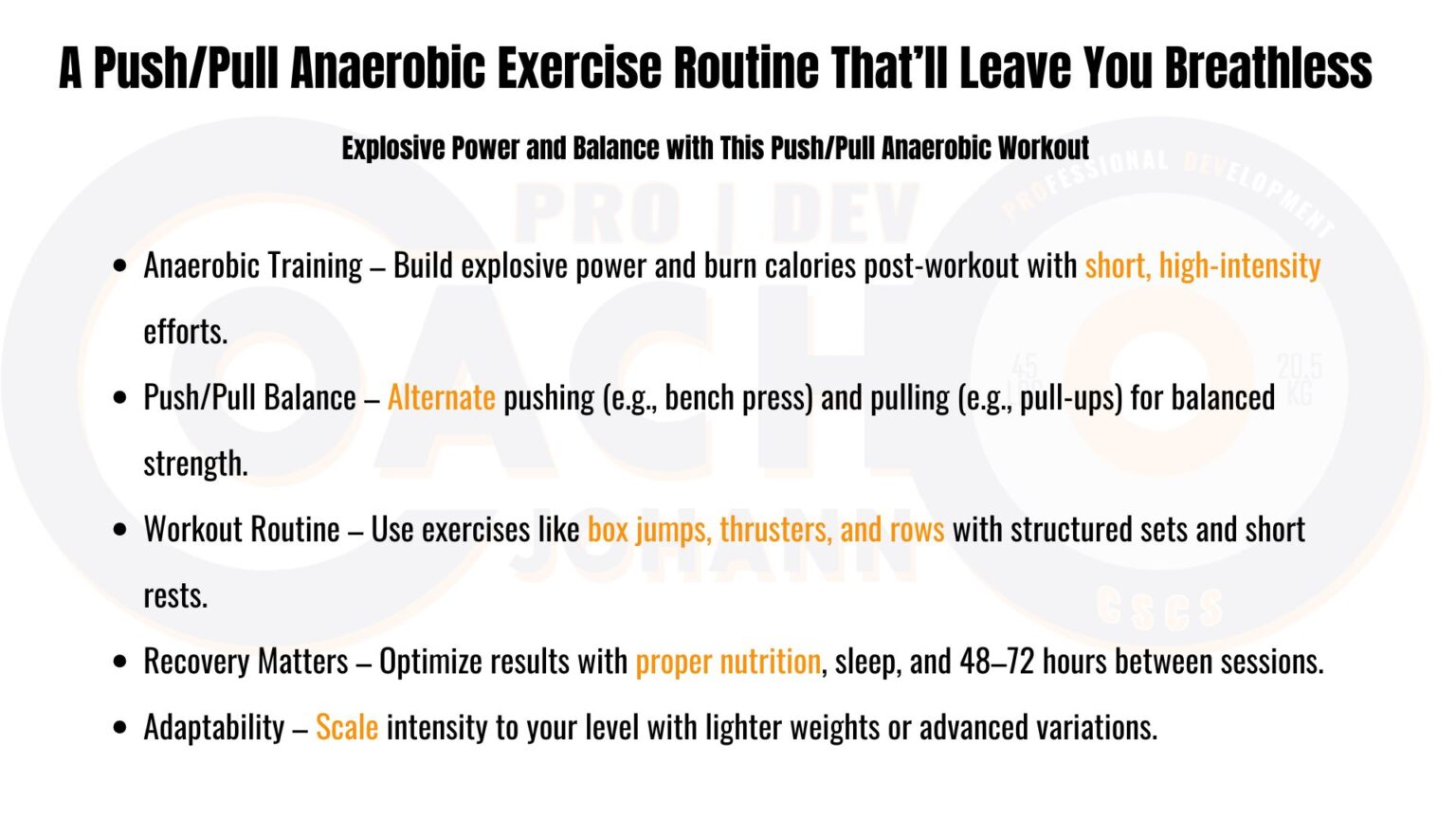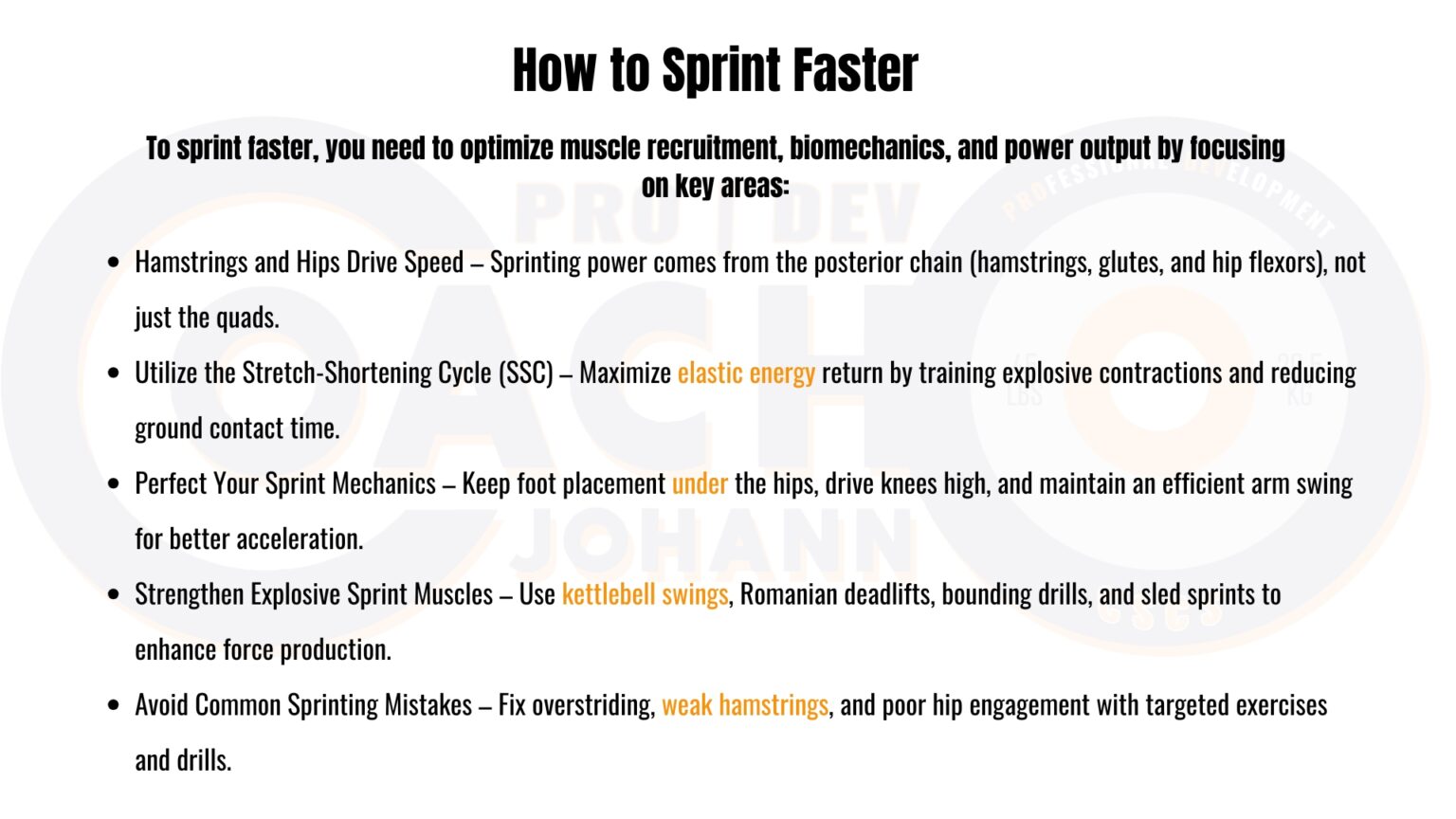Your cart is currently empty!
Category: Strength Training
-

Secrets of Kettlebell Swing Mastery and Kettlebell Techniques
Secrets of Kettlebell Swing Mastery and Kettlebell Techniques

An athlete performing a kettlebell clean inside a gym, demonstrating strength and precision in kettlebell training. The kettlebell swing is more than an exercise; it’s the foundation of explosive strength, functional fitness, and total-body power. While many fitness enthusiasts include swings in their routines, few truly understand the intricacies required to maximize their benefits. The kettlebell swing offers a unique combination of strength training and cardiovascular conditioning, making it one of the most efficient exercises available.
Widely regarded as a cornerstone of kettlebell training, the swing integrates multiple muscle groups, including the glutes, hamstrings, and core, to deliver a full-body workout. Unlike isolated movements, the swing demands coordination, timing, and precision to execute properly. It strengthens the posterior chain, improves posture, and builds the explosive power necessary for athletic performance.
Perfecting your swing unlocks a world of benefits—from building endurance and torching calories to enhancing mobility and reducing the risk of injury. However, this seemingly simple movement requires precision, technique, and dedication to master. The way you grip the kettlebell, the position of your hips, and the power behind your drive all work together to create an effective and safe swing. Without the right approach, you risk plateauing or, worse, injuring yourself.
This guide serves as a comprehensive resource for kettlebell swing mastery. We will break down form fundamentals, address common mistakes, and introduce advanced variations to enhance your training. Whether you’re new to kettlebells or looking to refine your technique, this post is your go-to resource for taking your swings to the next level. Let’s dive deep into the secrets of kettlebell swing mastery, ensuring you unlock your full potential with this essential movement.
Mastering the Basics of the Kettlebell Swing
Setting Up for Success
The foundation of a great kettlebell swing lies in proper setup. Without this crucial step, you risk compromising your technique and missing out on the full benefits of the movement. Setting up correctly ensures that your body is aligned, your muscles are primed, and your mind is focused on the task ahead.
This initial preparation not only enhances performance but also minimizes the risk of injury, allowing for smoother progression into more advanced variations. A strong setup serves as the blueprint for mastering the swing, building a connection between your mind and body that translates into powerful, controlled movements every time.
Stance and Positioning
Stand with your feet slightly wider than shoulder-width, toes pointed outward at a natural angle.
Place the kettlebell about 12–18 inches in front of you on the floor to encourage proper hip hinge mechanics.
Distribute your weight evenly across your feet to ensure stability and prevent unnecessary sway during the movement.
Engage your shoulders and keep your chest proud to set a strong, controlled position.
Hinge, Don’t Squat
Push your hips back while maintaining a neutral spine and a slight bend in your knees.
Ensure your knees track over your toes without excessive inward or outward movement.
Practice with a dowel along your back to ensure proper alignment and hinge mechanics.
Remember, your hips—not your knees—should drive the movement, creating power from the posterior chain.
Grip
Use a firm but relaxed grip, engaging your forearms and lats to stabilize the kettlebell. Avoid over-gripping, which can cause unnecessary tension in your arms and shoulders.
Hold the handle close to its base for improved control and wrist stability.
Keep your wrists neutral throughout the movement to avoid strain.
Engage Your Core
Brace your core as if preparing for impact. This stabilizes your spine and prevents unnecessary movement.
Visualize pulling your ribcage down and tucking your pelvis slightly to engage the transverse abdominis.
Avoid excessive arching in your lower back by maintaining tension in your abdominal muscles.
By mastering these setup fundamentals, you’ll lay a solid foundation for powerful and effective kettlebell swings, reducing your risk of injury while maximizing efficiency. This initial setup ensures not only correct form but also enhances the potential to progress into advanced variations.
It builds confidence for beginners and solidifies technique for seasoned practitioners, making every movement purposeful and impactful. A strong setup is the key to unlocking the full spectrum of benefits that the kettlebell swing offers, from improved posture to increased explosive power.
Executing the Swing
The Hike
Bend at the hips and grab the kettlebell with both hands, pulling it back between your legs like a football hike.
Keep your shoulders packed and avoid rounding your upper back.
Maintain tension in your hamstrings and glutes as you prepare to drive the kettlebell forward.
The Drive
Explosively extend your hips by contracting your glutes and hamstrings, propelling the kettlebell upward.
Engage your lats to control the movement and keep the kettlebell close to your body.
Focus on generating power through your hips rather than lifting with your arms.
The Float
At the top of the swing, the kettlebell should feel weightless, reaching about chest height. Your arms remain straight but relaxed.
Keep your shoulders down and your wrists neutral to avoid unnecessary strain.
Ensure the kettlebell’s handle stays parallel to the ground for proper balance and control.
The Descent
Let gravity guide the kettlebell back between your legs, controlling the motion with your hips and maintaining core tension.
Use your hamstrings to decelerate the movement, preventing the kettlebell from pulling you forward.
Keep your knees soft but stable to absorb the downward force without collapsing.
Each phase of the swing builds upon the other, creating a seamless and efficient movement that maximizes power, control, and endurance. The fluid transition between phases ensures that energy is not wasted, enabling the body to work as a cohesive unit. By mastering this progression, you develop both strength and efficiency, allowing for longer and more effective training sessions.
Common Mistakes and How to Fix Them

Three colorful kettlebells of different weights placed on a gym floor, representing progression and variety in kettlebell training. Even experienced lifters can fall into common pitfalls during kettlebell swings, which can hinder progress and increase the risk of injury. Identifying and addressing these mistakes early ensures you maximize the efficiency and safety of your workouts. Each error stems from specific biomechanical or technical issues, but with targeted solutions, you can refine your swing and unlock its full potential.
Mistake 1: Using Your Arms Instead of Your Hips
Problem: Many beginners try to lift the kettlebell with their arms, rather than driving the movement from the hips. This often stems from a lack of awareness about proper hip hinge mechanics or insufficient posterior chain strength. Using the arms as the primary driver not only reduces the swing’s effectiveness but also increases the risk of shoulder strain.
Solution: Focus on creating power through a strong hip hinge. Visualize your arms as hooks guiding the kettlebell. Incorporate glute bridges and banded hip thrusts to strengthen your posterior chain and reinforce proper movement mechanics.
Mistake 2: Rounding Your Back
Problem: A rounded back places undue stress on the lumbar spine and increases the risk of injury. This issue is often caused by a lack of core engagement or poor postural awareness during the movement. Rounding the back not only compromises safety but also diminishes the efficiency of the swing, limiting the potential for power generation.
Solution: Engage your core and maintain a neutral spine. Adding exercises like bird dogs and planks can improve core stability. Practicing Romanian deadlifts can also help reinforce proper spinal alignment during hip-dominant movements.
Mistake 3: Squatting Instead of Hinging
Problem: Squatting shifts the focus away from the posterior chain, reducing the effectiveness of the swing. This misstep often arises from confusion about the mechanics of a proper hip hinge versus a squat pattern. It not only limits the engagement of critical muscles like the glutes and hamstrings but also detracts from the explosive power needed for an efficient swing.
Solution: Use a dowel to practice the hip hinge and focus on moving your hips back. Add Romanian deadlifts to your routine to further strengthen hinge mechanics. Ensure your knees remain slightly bent but do not drive the movement.
Mistake 4: Overextending the Arc
Problem: Allowing the kettlebell to swing too high or far away from your body wastes energy and strains your shoulders. This often occurs when lifters use excessive force or fail to control the arc of the swing. Overextending the arc not only reduces efficiency but also places unnecessary strain on the shoulder joint, potentially leading to discomfort or injury.
Solution: Stop the swing at chest height, keeping the kettlebell close to your center of gravity. Engage your lats and use mirrors or video to monitor your form.
Detailed Muscle Anatomy and Activation
Gluteus Maximus
The glutes are the primary movers during the swing, driving hip extension and creating explosive power. They originate from the posterior iliac crest and sacrum, inserting onto the femur and iliotibial band. Strong glutes improve athletic performance in activities like sprinting and jumping, while also supporting the lower back. In the kettlebell swing, the glutes ensure that hip extension is forceful and controlled, providing the explosive power needed to drive the kettlebell upward and maintain proper form throughout the movement.
Hamstrings (Biceps Femoris, Semitendinosus, Semimembranosus)
The hamstrings assist in both power generation during the upswing and deceleration during the descent. They act as key stabilizers for the knee joint. Originating from the ischial tuberosity and inserting onto the tibia and fibula, these muscles are essential for controlling the pendulum-like motion of the kettlebell swing. Proper engagement of the hamstrings ensures smooth transitions between phases of the swing, reducing strain on the lower back and enhancing overall efficiency.
Erector Spinae
These muscles maintain spinal alignment, preventing excessive flexion or extension. Originating from the sacrum and iliac crest and inserting onto the vertebrae and ribs, they are critical for posture and reducing the risk of back injuries during heavy lifts. In kettlebell swings, the erector spinae act as stabilizers, ensuring the spine remains neutral despite the dynamic movement. This stability protects the lower back and enhances the transfer of power from the hips to the kettlebell.
Latissimus Dorsi
The lats stabilize the kettlebell’s movement and keep it close to the body. These muscles originate from the lower thoracic vertebrae, lumbar vertebrae, iliac crest, and sacrum, inserting onto the humerus. During kettlebell swings, the lats ensure that the kettlebell follows a controlled arc, reducing unnecessary shoulder movement and aiding in the deceleration phase. Proper activation of the lats enhances shoulder stability and prevents the kettlebell from drifting too far forward, ensuring a safe and effective swing.
For Fighters: Why the Kettlebell Swing Is Essential
Why the Kettlebell Swing is Essential for Fighters
Fighters require a unique combination of explosive power, rotational strength, and muscular endurance to excel in their discipline. The kettlebell swing is a highly efficient training tool that develops all these attributes simultaneously. By focusing on explosive hip drive and core engagement, the swing mimics the movements required in striking, grappling, and defensive maneuvers. Additionally, it strengthens the posterior chain and improves overall athletic performance, making it indispensable for combat athletes.
Improved Punching Power
The explosive hip extension in kettlebell swings directly translates to more powerful punches. Stronger hips provide a stable base for generating force, leading to faster and harder strikes. Enhanced hip drive also improves reaction time and efficiency in delivering combos.
Rotational Stability
Core engagement during swings enhances rotational strength, essential for maintaining balance during quick directional changes. This stability ensures that fighters can throw accurate punches and kicks while staying grounded and avoiding counterattacks.
Grip Strength
The prolonged grip required to control the kettlebell builds forearm and hand endurance. This endurance is crucial for grappling, clinch work, and maintaining control during submissions, giving fighters a significant edge in close-contact situations.
Improved Punching Power: The hip drive in swings translates directly into the mechanics of throwing powerful punches. Stronger hips equal faster, harder strikes.
Rotational Stability: Core engagement during swings enhances rotational strength, crucial for maintaining balance during quick directional changes.
Grip Strength: Prolonged grip endurance is vital for maintaining control during grappling and clinches. Swings strengthen the grip muscles without isolating them.
Kettlebell Progressions and Advanced Techniques
Once you’ve mastered the basic kettlebell swing, advancing your training with progressions and variations is the next logical step. These advanced techniques not only add variety but also increase the physical and mental demands of your workouts, ensuring continued growth and engagement.
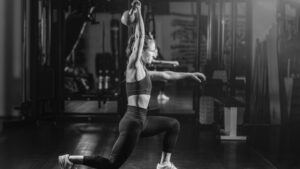
A female athlete executing a kettlebell snatch in a gym, showcasing advanced kettlebell training and explosive power development. Single-Arm Kettlebell Swings
The single-arm kettlebell swing is an excellent way to introduce asymmetry into your training, forcing your core to stabilize against rotational forces. This variation emphasizes coordination, grip strength, and balance while targeting similar muscle groups as the two-handed swing.
How to Perform:
Begin in the standard swing setup position with the kettlebell in one hand.
Hike the kettlebell back between your legs, keeping your free arm extended out for balance.
Drive your hips forward explosively to propel the kettlebell upward to chest height.
Maintain a neutral spine and avoid rotating your torso.
Switch arms after completing the desired number of repetitions.
Double Kettlebell Swings
Double kettlebell swings are a powerhouse move that demands explosive power and advanced coordination. This variation increases the load on your hips, glutes, and hamstrings while challenging your grip strength and overall control.
How to Perform:
Start with two kettlebells positioned between your feet.
Grip both handles and hike the kettlebells back between your legs.
Drive your hips forward to generate power, swinging both kettlebells up to chest height.
Keep the kettlebells moving in a controlled, synchronized arc.
Ensure your stance is wide enough to accommodate both kettlebells without compromising your form.
Kettlebell High Pulls
High pulls add an upper-body focus to the traditional swing, engaging the traps, shoulders, and upper back. This variation improves pulling power and transitions seamlessly into snatches or cleans.
How to Perform:
Begin with the kettlebell in both hands or one hand for a unilateral variation.
Swing the kettlebell up and use your upper back and traps to pull it toward your chest.
Lead with your elbows, keeping them higher than your wrists throughout the movement.
Reverse the motion by letting the kettlebell descend back into the swing position.
Focus on explosive power during the pull phase and control on the descent.
Kettlebell Snatches
The snatch is a dynamic, full-body movement that transitions the kettlebell from the ground to overhead in one fluid motion. It enhances speed, power, and shoulder stability while demanding precision.
How to Perform:
Start with the kettlebell in one hand, positioned between your feet.
Hike the kettlebell back and drive your hips forward, propelling the kettlebell overhead in one fluid motion.
Punch your hand through the handle at the top to stabilize the kettlebell.
Control the descent by guiding the kettlebell back to the starting position.
Practice with lighter weights to master the movement before progressing to heavier loads.
Kettlebell Clean and Press
The clean and press combines a lower-body pull with an upper-body push, making it a comprehensive strength-building exercise. It improves coordination, core strength, and shoulder stability.
How to Perform:
Begin with the kettlebell on the floor between your feet.
Clean the kettlebell to the rack position by using your hips to drive the weight up.
Once in the rack position, press the kettlebell overhead while keeping your core engaged.
Lower the kettlebell back to the rack position and repeat the process.
Focus on smooth transitions between the clean and press phases.
Advanced Variations for Athletes
Side Swings
Side swings challenge your ability to control lateral forces, making them perfect for improving rotational strength and oblique engagement. They’re ideal for athletes needing powerful core rotation, like golfers and fighters.
How to Perform:
Start in the traditional swing position with the kettlebell between your feet.
Swing the kettlebell diagonally across your body, finishing with it at shoulder height on one side.
Engage your obliques and core to maintain control and prevent excessive rotation.
Return the kettlebell to the starting position and alternate sides.
Alternate Stance Swings (Heel-Up)
This variation shifts the emphasis to single-leg stability and improves balance. It mimics athletic movements where staggered stances are common, such as sprinting or martial arts.
How to Perform:
Assume a staggered stance with one foot slightly forward and the opposite heel lifted.
Perform the swing as usual, ensuring your weight remains evenly distributed between both legs.
Switch your stance after completing the desired number of repetitions.
This variation emphasizes single-leg stability and core engagement.
Gunslinger Swings
The gunslinger swing incorporates rotational force and grip strength into a single movement. This variation is excellent for building shoulder stability and dynamic rotational power.
How to Perform:
Begin in a standard swing setup with the kettlebell in one hand.
Swing the kettlebell up and allow it to rotate outward slightly as it rises.
At the top, your palm should face inward, mimicking a gunslinger drawing a pistol.
Control the kettlebell on the descent and repeat on the opposite side.
Figure-Eight Swings
Figure-eight swings are a coordination-heavy exercise that tests grip strength, timing, and core stability. They’re a fun, dynamic way to add variety to your kettlebell workouts.
How to Perform:
Hold the kettlebell in one hand and pass it between your legs in a figure-eight motion.
Use your hips to drive the movement while maintaining a stable, neutral spine.
Focus on smooth transitions as the kettlebell moves from hand to hand.
This variation improves coordination, grip strength, and dynamic core stability.
Integrating Kettlebell Swings Into Your Training
Sample Workouts
Beginner
3 rounds of 15 two-arm swings
Rest 60 seconds between rounds
Intermediate
5 rounds of 20 one-arm swings (10 per arm)
Rest 45 seconds between rounds
Advanced
10 rounds of 15 double kettlebell swings
Rest 30 seconds between rounds
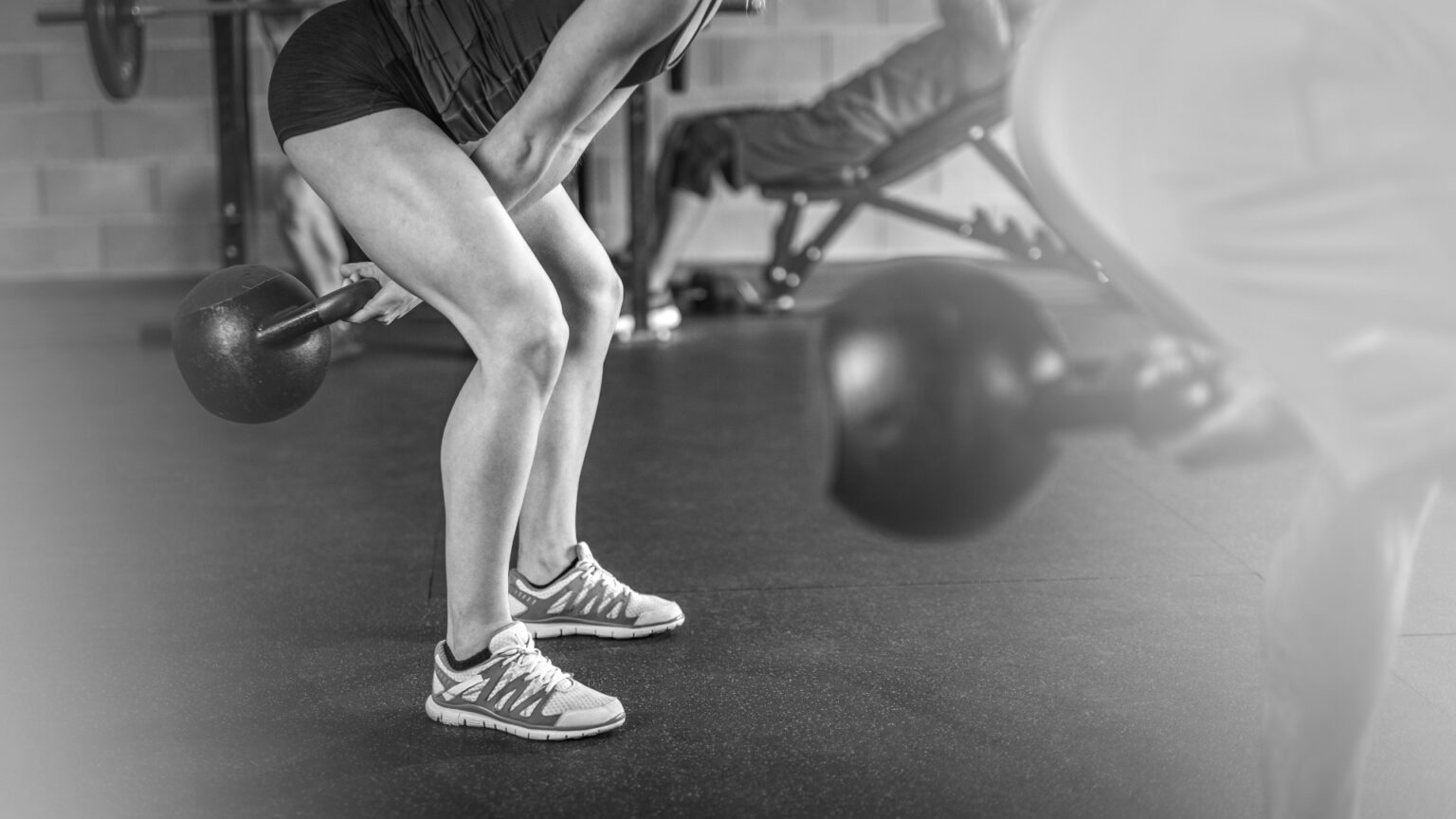
Close-up of a kettlebell swing in motion, emphasizing proper hip hinge mechanics and grip strength during training. Key Muscle Activation During Kettlebell Swings
Muscle Group Primary Function Exercise Relevance Gluteus Maximus Hip extension and power generation Drives the upward phase of the swing Hamstrings Hip extension and knee stabilization Controls the descent and assists in power Core (Rectus Abdominis, Obliques) Stabilization and force transfer Resists rotation and stabilizes the spine Trapezius and Lats Shoulder stabilization and control Maintains smooth kettlebell trajectory Forearm Muscles Grip strength and endurance Ensures secure kettlebell handling In Closing…
The kettlebell swing is a functional, powerful exercise that enhances strength, endurance, and athleticism. When performed correctly, it delivers unparalleled benefits, bridging the gap between strength and cardio training. Whether you’re a beginner or an advanced athlete, swings offer scalable challenges that grow with your fitness level, ensuring continuous improvement in both skill and strength. By mastering this exercise, you can lay the groundwork for advanced variations that enhance functional movement patterns.
Key takeaways:
Master the basics of the swing before progressing to advanced variations. A solid foundation ensures safe execution and optimal performance.
Avoid common mistakes like rounding your back or using your arms to lift the kettlebell. Proper form is the key to maximizing benefits while preventing injury.
Consistency and attention to detail are vital for maximizing benefits and preventing injury. Practicing regularly with focus ensures long-term success and adaptability.
For fighters and athletes, advanced variations such as side swings, figure-eight swings, and gunslingers are invaluable for developing functional strength, coordination, and power. These progressions challenge the body in dynamic ways, fostering improvements in rotational strength, core engagement, and balance. Each variation offers unique benefits, allowing you to target specific athletic attributes while maintaining the fundamental principles of the swing.
Remember, the kettlebell swing is more than an exercise—it’s a gateway to functional fitness and athletic excellence. Whether your goal is improved performance, injury prevention, or overall fitness, the kettlebell swing delivers results that matter. Stay committed to perfecting your technique, pushing your limits, and enjoying the process as you unlock your full potential. With every swing, you move closer to mastering a tool that empowers your body and enhances your athletic capabilities.
FAQ Section
For beginners, men typically start with a 16 kg (35 lbs) kettlebell, while women can start with 8-12 kg (18-26 lbs). Advanced practitioners can progress to heavier weights as technique improves.
Start with 3-4 sets of 10-15 repetitions. As you build endurance and strength, you can increase the number of sets or incorporate time-based intervals.
While swings are highly effective, recovery is essential. Aim for 3-4 sessions per week, allowing rest days for muscle recovery and growth.
Yes, swings are excellent for burning calories and improving cardiovascular fitness, making them a great addition to weight loss programs when combined with a healthy diet.
Avoid using your arms to lift the kettlebell, rounding your back, squatting instead of hinging, and overextending the arc of the swing. Focus on proper hip drive and maintaining a neutral spine.
Resources
coachjohanncscs.com only uses primary research and scholarly studies as references over secondary sites. Other references are primarily from reputable social media accounts of experts only in the fields of health, nutrition, sports science, physiology, psychology, and physical therapy.
- Hernandez-Martinez, J., & Cid-Calfucura, I. (2024). Acute and chronic effects of muscle strength training on physical fitness in boxers: A scoping review. MDPI. https://www.mdpi.com/2076-3417/14/21/9706
- Tropin, Y., Podrigalo, L., & Romanenko, V. (2024). Using static-dynamic exercises to improve strength performance in elite Brazilian Jiu-Jitsu athletes. EFSUPIT. https://www.mdpi.com/1660-4601/21/8/1019
- Chapman, D. W., & Secomb, J. L. (2024). Training power for individual sports. Developing Power, 2024.
- Liu, Y., Huang, Z., & Zhou, Z. (2024). The effect of optimal load training on punching ability in elite female boxers. Frontiers in Physiology. https://www.frontiersin.org/journals/physiology/articles/10.3389/fphys.2024.1455506/full
- Herrera-Valenzuela, T., Ojeda-Aravena, A., & Sanz-Matesanz, M. (2024). A systematic review with meta-analysis on the effects of plyometric-jump training on the physical fitness of combat sport athletes. MDPI. https://www.mdpi.com/2075-4663/11/2/33
- Hernandez-Martinez, J., & Cid-Calfucura, I. (2024). Optimizing US Army Combat Readiness. Oxford University Press. https://www.mdpi.com/2075-4663/11/2/33
- Antonov, A. V., & Nikulin, E. I. (2024). Strength and conditioning for mixed martial arts athletes. Teoriya. http://www.teoriya.ru/sites/default/files/theory8_2020-na_sayt.pdf#page=20
- Mocanu, G. D., Murariu, G., & Badicu, G. (2023). Variations of explosive strength for the students of the faculty of physical education and sports depending on the type of sports activities. Journal of Medicine and Health. https://www.jomh.org/articles/10.22514/jomh.2023.099
-
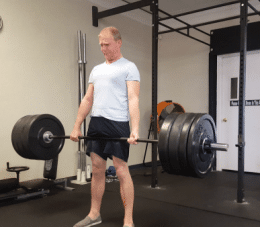
Push–Pull Anaerobic Exercise Routine: Build Explosive Power
A Push/Pull Anaerobic Exercise Routine That’ll Leave You Breathless

Master your anaerobic push/pull routine with powerhouse moves like the kettlebell press. Build explosive strength and stability. Anaerobic workouts are the unsung heroes of fitness. While aerobic exercises like running and cycling often steal the spotlight, anaerobic training brings an entirely different level of intensity and benefits. Designed to push your body to its limits, anaerobic exercises rely on short bursts of high-intensity effort, engaging your fast-twitch muscle fibers, and maximizing calorie burn long after your workout ends.
If you’ve ever wondered how to take your strength, endurance, and metabolic health to the next level, anaerobic workouts are your answer. This guide dives deep into an effective push/pull anaerobic exercise routine, explains the science behind these exercises, and highlights why they are essential for everyone from athletes to everyday gym-goers.
The Science of Anaerobic Training: Pushing Past the Wall
Anaerobic exercise, by definition, is training without relying on oxygen as the primary energy source. This type of training predominates during short, high-intensity efforts ranging from one second to about 90 seconds. It taps into your body’s stored energy reserves, primarily glycogen, and relies on the anaerobic glycolysis energy system.
The beauty of anaerobic training lies in its efficiency. While aerobic workouts condition your cardiovascular system, anaerobic sessions build strength, speed, and power. More importantly, they train your body to conserve energy, improve your VO2 max, and delay hitting the proverbial “wall.”
Key benefits include:
- Enhanced metabolic capacity: Burn calories even hours after the workout.
- Improved power output: Build explosive strength critical for athletes and high-performance fitness.
- Increased lactate threshold: Train harder for longer by improving your body’s ability to buffer lactic acid.
Anaerobic training also has a carryover effect, improving your performance in aerobic activities by making your body more efficient at managing energy systems.
The Push/Pull Approach: Building Balance and Power
One of the most effective ways to structure anaerobic workouts is through a push/pull routine. This method alternates between pushing exercises (e.g., bench press, push-ups) and pulling exercises (e.g., pull-ups, rows). The push/pull approach ensures balanced muscle development, prevents overuse injuries, and engages both the anterior and posterior chains for a complete workout.
Push/Pull Anaerobic Workout Plan: Beginner-Friendly and Advanced Options
Warm-Up: Preparing for Intensity Before diving into the routine, take 5–10 minutes to warm up. Dynamic stretches, mobility drills, and light cardio are essential to prime your muscles and joints for the high-intensity effort.
Workout Overview: Anaerobic Push/Pull Routine
Set 1: Upper Body Strength and Stability
Decline Bench Press
- Reps: 15 (70% max), 12, 10, 8 (85% max)
- Focus on explosive pushing power, engaging the chest, shoulders, and triceps.
- Why it works: The decline angle emphasizes the lower chest, building strength for real-world pressing movements.
Pull-Ups
- Reps: 5 reps (add weight if advanced)
- Perform controlled movements, focusing on the eccentric phase to engage the lats and biceps.
- Why it works: Pull-ups are the gold standard for upper body pulling strength, directly targeting the posterior chain.
Rest: 2 minutes between sets.
Set 2: Back and Chest Development
Bent Dumbbell Rows
- Reps: 8–12 (increase weight by 5% each set)
- Keep your back flat and row explosively, squeezing your shoulder blades at the top.
- Why it works: Targets the lats, traps, and rear delts, building upper back strength critical for posture and pulling power.
Incline Dumbbell Flyes
- Reps: 10 reps at 50% max
- Maintain a slight bend in your elbows and stretch at the bottom to maximize range of motion.
- Why it works: Flyes isolate the chest muscles while improving flexibility and mobility in the shoulders.
Rest: 1:1.5 ratio (set takes 2 minutes, rest for 2.5 minutes).
Set 3: Core and Explosiveness
Toe-to-Bar
- Reps: 15
- Focus on controlled, explosive hip flexion to lift your toes to the bar.
- Why it works: Engages the entire core, improving spinal stability and explosive power.
36″ Box Jumps
- Reps: 8–12
- Jump explosively, land softly, and immediately reset for the next jump.
- Why it works: Box jumps are an anaerobic powerhouse, training lower body explosiveness and plyometric ability.
Rest: 2 minutes between sets.
Set 4: Power and Conditioning

Barbell thrusters combine strength, mobility, and anaerobic endurance in one dynamic move. Thrusters
- Reps: 21, 18, 15, 12 (as fast as possible)
- A full-body movement combining a front squat with an overhead press.
- Why it works: Thrusters build total-body strength and anaerobic capacity, pushing your heart rate to its max.
Pull-Ups (Superset)
- Reps: 8–15
- Alternate with thrusters to maintain intensity.
- Why it works: Supersets keep your heart rate elevated while maximizing strength and endurance gains.
The Role of Recovery in Anaerobic Training
Anaerobic workouts are intense and place significant stress on your muscles, nervous system, and cardiovascular system. Recovery is not just a luxury—it’s a necessity. Without adequate rest, your body cannot repair the micro-tears in your muscles or replenish its glycogen stores, both of which are critical for progress.
Why Recovery Matters
Muscle Repair: Anaerobic training causes small tears in muscle fibers, which are repaired during recovery, leading to strength and size gains.
Nervous System Reset: High-intensity efforts can tax your nervous system, reducing your ability to generate force in subsequent sessions.
Hormonal Balance: Recovery helps regulate hormones like cortisol, which can spike during intense training, and boosts anabolic hormones like testosterone and growth hormone.
Recovery Strategies for Anaerobic Workouts
Active Recovery: Engage in low-intensity activities like walking, yoga, or swimming to promote blood flow and reduce muscle soreness.
Nutrition: Focus on replenishing glycogen with carbohydrate-rich meals and aiding muscle repair with high-quality protein.
Sleep: Aim for 7–9 hours of sleep per night to facilitate full recovery and optimize performance.
Rest Days: Schedule at least one or two rest days per week, especially after particularly grueling sessions.
How to Time Recovery For push/pull anaerobic workouts, a rest ratio of 1:1.5 is ideal during the session. Between sessions, allow 48–72 hours for recovery of the targeted muscle groups before repeating.
The Benefits of Anaerobic Push/Pull Training
Increased Strength and Power Push/pull routines develop balanced strength across opposing muscle groups, reducing injury risk and improving functional fitness.
Efficient Calorie Burn Anaerobic workouts boost your metabolism for hours post-workout, thanks to the afterburn effect (EPOC).
Improved Endurance Training your anaerobic system increases your lactate threshold, allowing you to sustain high-intensity efforts for longer.
Enhanced Athletic Performance Whether you’re a sprinter, fighter, or CrossFit enthusiast, push/pull anaerobic training improves the explosive power and endurance needed for peak performance.
Tips for Success: Maximizing Your Routine
Progress Gradually
- Start with lighter weights and fewer reps, gradually increasing intensity as your fitness improves.
Prioritize Recovery
- Anaerobic workouts are intense; ensure you’re getting adequate rest, hydration, and nutrition to support recovery.
Track Your Progress
- Keep a journal of weights, reps, and times to measure improvement over time.
Common Mistakes to Avoid
Skipping the Warm-Up
- Anaerobic workouts demand maximum effort, so warming up is critical to prevent injury.
Overtraining
- The high intensity of anaerobic training can lead to burnout if done too frequently. Stick to 2–3 sessions per week.
Ignoring Form
- Poor technique increases injury risk. Focus on controlled, precise movements over heavy loads.
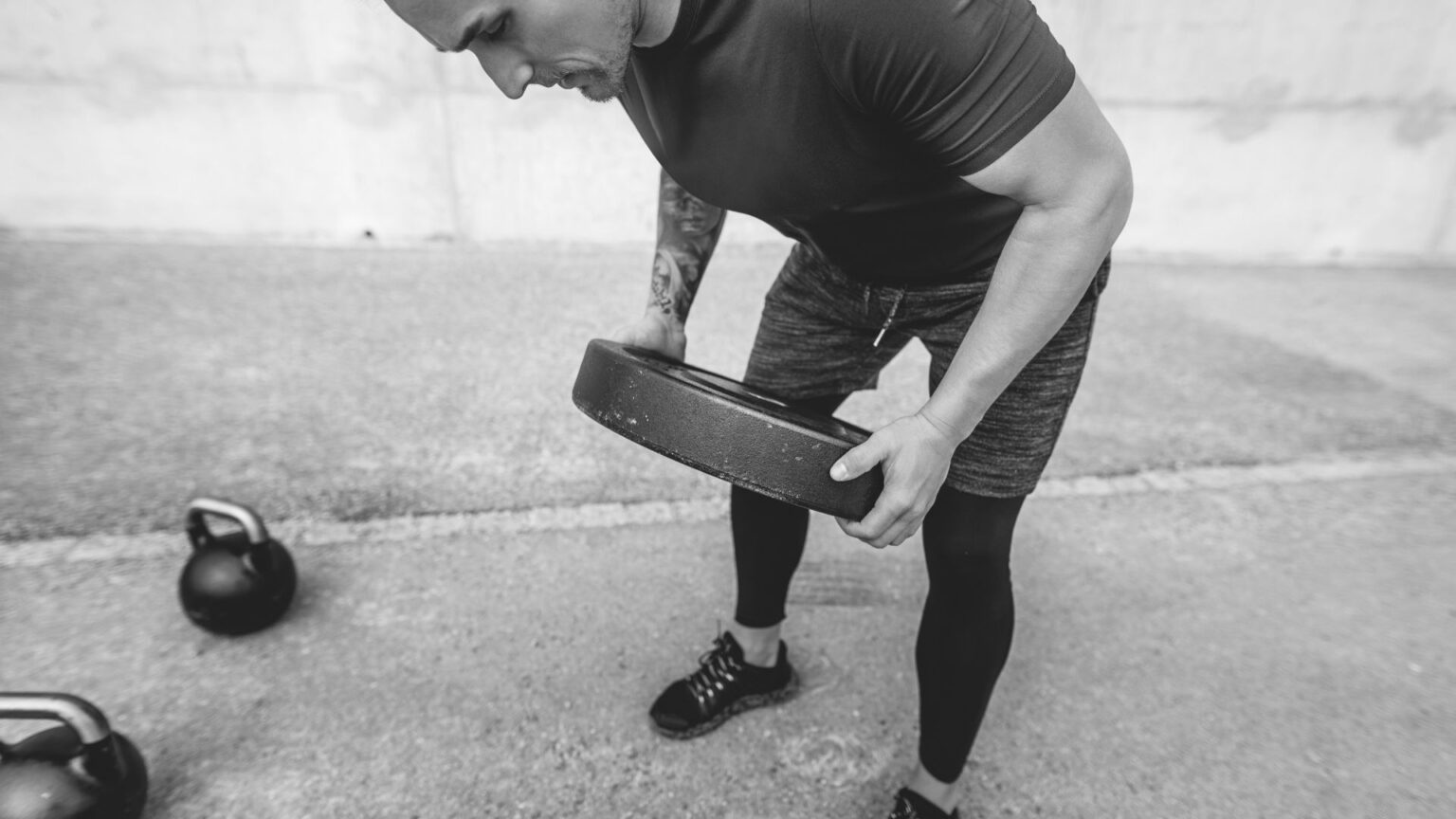
Strengthen your pull: Bent-over rows develop upper-back and posterior chain strength—key for a well-rounded anaerobic program. Table: Push/Pull Anaerobic Routine Overview
Exercise Reps Sets Rest Between Sets Target Area Decline Bench Press 15, 12, 10, 8 4 2 minutes Chest, Triceps Pull-Ups 5 4 2 minutes Back, Biceps Bent Dumbbell Rows 8–12 4 2.5 minutes Back, Posterior Chain Incline Dumbbell Flyes 10 4 2.5 minutes Chest, Shoulders Toe-to-Bar 15 3 2 minutes Core 36″ Box Jumps 8–12 3 2 minutes Lower Body, Plyometric Thrusters 21, 18, 15, 12 4 2 minutes Full Body In Closing…
Anaerobic push/pull training isn’t just about breaking a sweat; it’s a strategic, science-backed approach to improving your strength, power, and endurance. By focusing on explosive movements and balanced muscle development, this routine challenges your body in ways traditional workouts simply can’t. Each session builds on core principles of metabolic efficiency, muscular balance, and enhanced recovery, making it suitable for athletes and gym-goers alike.
Key Takeaways:
- Build Explosive Power and Strength: Anaerobic training focuses on fast-twitch muscle fibers, the ones responsible for high-intensity, explosive movements like sprints, jumps, and lifts.
- Balanced Development with Push/Pull Routines: Alternating between pushing and pulling movements ensures that no muscle group is overused while others are neglected. This not only prevents injury but also fosters a well-rounded physique.
- Recovery is Critical: Anaerobic exercises place significant demands on the body. Proper recovery through nutrition, rest, and active recovery days ensures consistent progress and prevents burnout.
Its ability to offer scalable intensity sets anaerobic push/pull training apart. Beginners can start with lighter weights and longer rest intervals, while advanced athletes can push their limits with higher loads, reduced recovery times, and advanced variations. This adaptability makes it one of the most versatile and effective approaches to fitness.
Take Action Today:
If you’re ready to take your fitness to the next level, incorporate this routine into your weekly schedule. Use it to challenge yourself, track your progress, and build a body that’s as powerful as it is balanced. Whether you’re preparing for competition, breaking through plateaus, or simply looking to improve your performance, anaerobic push/pull training offers the tools you need to achieve your goals.
Remember, every rep, every set, and every drop of sweat brings you closer to unlocking your full potential. Stay consistent, train smart, and embrace the challenge—because the rewards are well worth the effort.
FAQ Section
Yes, absolutely! Beginners can adapt this routine by starting with lighter weights, fewer sets, and longer rest periods. Focus on mastering form and building a solid foundation before increasing intensity. For example, instead of 15 reps at 70% max, start with 10–12 reps at 50% max and gradually progress as your strength and endurance improve.
For optimal results, aim to perform this anaerobic push/pull routine 2–3 times per week. Be sure to allow at least 48–72 hours of recovery between sessions to prevent overtraining and ensure proper muscle repair. If paired with other types of training, adjust your schedule to maintain balance and avoid burnout.
This routine requires basic gym equipment:
- A barbell for heavy lifts like thrusters or bench presses.
- Dumbbells for rows, flyes, and other isolation movements.
- A pull-up bar for bodyweight exercises.
- A sturdy box or bench for explosive box jumps.
If you don’t have access to a gym, modifications can be made using resistance bands or household items for added resistance.
Recovery is crucial to maximize gains from anaerobic training. Here’s how to optimize your recovery:
- Nutrition: Refuel your body with protein-rich foods and complex carbohydrates within 30 minutes of finishing your workout.
- Hydration: Drink plenty of water or electrolyte-rich drinks to replenish lost fluids.
- Active Recovery: Incorporate low-intensity activities like walking, yoga, or stretching on rest days to promote blood flow and reduce muscle soreness.
- Sleep: Aim for 7–9 hours of sleep per night to allow your body to repair and rebuild.
Signs of overtraining include prolonged muscle soreness, chronic fatigue, decreased performance, irritability, and difficulty sleeping. If you experience any of these symptoms, scale back your workouts and prioritize rest and recovery. Overtraining can hinder progress and increase the risk of injury.
Yes, this push/pull routine complements other training styles like aerobic conditioning, plyometrics, or sport-specific drills. For example, you can combine it with a running program or martial arts training to build both strength and endurance. Just be mindful of recovery and ensure you’re not overloading your weekly schedule.
Anaerobic training builds:
- Explosive power and speed.
- Muscular endurance and resilience.
- A faster metabolism, thanks to the afterburn effect (EPOC).
- A stronger mental grit to push through discomfort during high-intensity efforts.
These benefits translate to better athletic performance and overall fitness.
Resources
coachjohanncscs.com only uses primary research and scholarly studies as references over secondary sites. Other references are primarily from reputable social media accounts of experts only in the fields of health, nutrition, sports science, physiology, psychology, and physical therapy.
Mcweeny, D.K., Boule, N.G., Neto, J.H.F., & Faria, I.E. (2020). Effect of high-intensity functional training and traditional resistance training on aerobic, anaerobic, and musculoskeletal fitness improvement. Journal of Physical Education and Sport. Retrieved from https://efsupit.ro/images/stories/iunie2020/Art%20243.pdf
O’Connor, R., Maksimovic, M., Porcari, J.P., & Schwab, E. (2020). Effects of various recovery modalities on lactate clearance and subsequent exercise performance. International Journal of Research in Exercise Physiology. Retrieved from https://ijrep.org/wp-content/uploads/lana-downloads/2020/11/oconnor.et_.al_.fall_.2020.pdf
Feito, Y., Heinrich, K. M., Butcher, S. J., & Poston, W. S. C. (2018). High-intensity functional training (HIFT): Definition and research implications for improved fitness. Sports, 6(3), 76. https://www.mdpi.com/2075-4663/6/3/76
Berning, J.M., Adams, K.J., & Climstein, M. (2007). Metabolic demands of “junkyard” training: Pushing and pulling a motor vehicle. The Journal of Strength and Conditioning Research. Retrieved from https://www.researchgate.net/publication/6153233_Metabolic_Demands_of_Junkyard_Training_Pushing_and_Pulling_a_Motor_Vehicle
Pettit, N.R. (2015). Examining the influence of recovery strategy and rest interval length on performance in trained and untrained individuals. University of Windsor. Retrieved from https://scholar.uwindsor.ca/etd/5659/
Smith, M. M., Sommer, A. J., Starkoff, B. E., & Devor, S. T. (2013). CrossFit-based high-intensity power training improves maximal aerobic fitness and body composition. The Journal of Strength and Conditioning Research. Retrieved from https://journals.lww.com/nsca-jscr/citation/2013/11000/CrossFit_Based_High_Intensity_Power_Training.30.aspx
Ratamess, N.A., Kang, J., & Porfido, T.M. (2016). Acute resistance exercise performance is negatively impacted by prior aerobic endurance exercise. The Journal of Strength and Conditioning Research. Retrieved from http://www.rodrigoallenatore.com/articoliscientificiPDF/ACUTE_RESISTANCE_EXERCISE_PERFORMANCE_IS.pdf
-

Blistering Upper Body Plyo Workouts | Power & Endurance Training
Blistering Upper Body Plyo Workouts (And For the Legs Too!)
- Johann CSCS
- Updated by Johann CSCS January 7, 2025

Determined athlete holding a plank position, preparing upper body and plyometrics training for endurance athletes. Plyometric training, often associated with explosive power and athleticism, is more than just a buzzword in fitness. These high-impact exercises are designed to maximize strength, speed, and agility by training your muscles to exert maximum force in short intervals. While lower-body plyometric exercises like box jumps and broad jumps are well-known, upper-body plyometrics are equally crucial, particularly for athletes looking to enhance overall performance.
Plyometric movements focus on the stretch-shortening cycle (SSC), a physiological mechanism that utilizes stored elastic energy to generate powerful movements. This unique combination of strength and speed builds muscular efficiency and coordination. By integrating plyometrics into your routine, you can experience improved neuromuscular function, better joint stability, and enhanced athletic performance. Beyond their physical benefits, these exercises demand mental focus and discipline, making them an excellent addition for athletes seeking to sharpen their competitive edge.
Whether you’re aiming to improve your punch power, vertical leap, or overall explosiveness, incorporating both upper- and lower-body plyometric exercises into your routine can unlock your full potential. This guide dives deep into effective exercises, the role of the stretch-shortening cycle, and actionable strategies for designing a balanced plyometric program—inspired by creativity and real-world training examples.
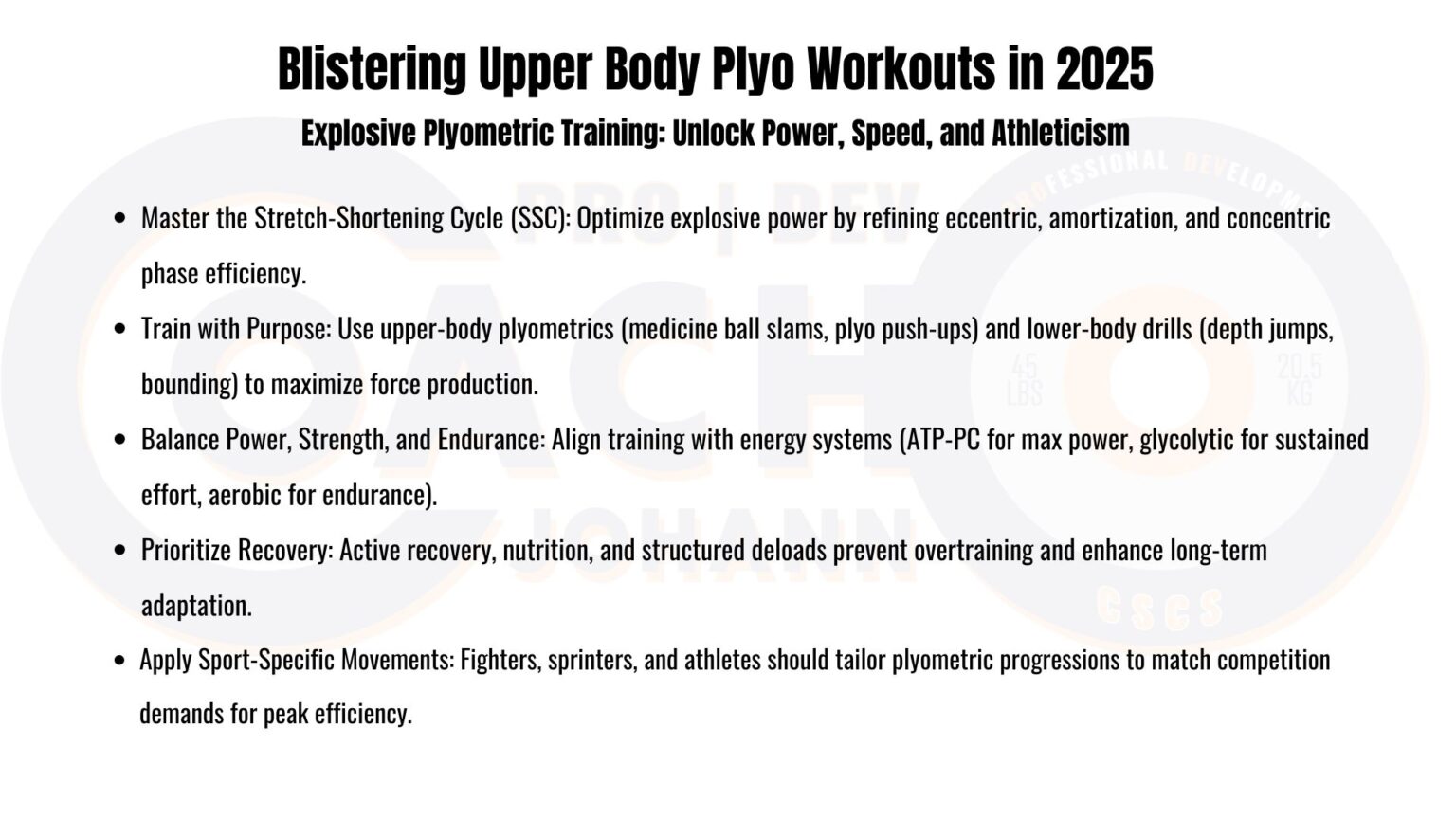
Understanding the Stretch-Shortening Cycle (SSC)
The stretch-shortening cycle (SSC) is the foundational principle behind plyometric training, enabling athletes to harness and amplify their natural power. This cycle involves three distinct phases—eccentric, amortization, and concentric—each playing a critical role in transforming stored energy into explosive movement.
The Three Phases of the SSC
- Eccentric Phase:
- During this phase, the muscle lengthens under tension, storing elastic energy like a coiled spring. For instance, when preparing to jump, the quads and calves stretch as the knees bend. This stretch activates muscle spindles, signaling the nervous system to prepare for a powerful contraction.
- Example: In sprinting, the hamstrings stretch during the heel strike, priming them for the push-off.
- Amortization Phase:
- This is the brief transition period between the eccentric and concentric phases. The shorter the amortization phase, the more efficiently the stored energy is utilized. Prolonged pauses dissipate energy, reducing explosive potential.
- Example: In a boxer’s punch, the time spent transitioning from the wind-up to the strike determines the punch’s power.
- Why It Matters: Minimizing the amortization phase is crucial for athletes in high-speed sports like sprinting and fighting, where milliseconds count.
- The muscle contracts, releasing the stored energy to produce movement. This is where the power is unleashed, propelling the body upward, forward, or laterally.
- Example: The upward drive in a vertical jump or the explosive release in a jab punch.Concentric Phase:
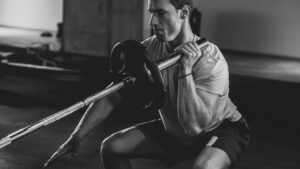
Athlete performing a barbell LANDMINE to build upper-body strength and balance. Why the SSC Matters
- Maximized Power Output: Efficient use of the SSC allows athletes to generate more force in less time, critical for actions like sprinting, jumping, and punching.
- Improved Coordination: Plyometric exercises train the neuromuscular system to synchronize muscle groups for seamless transitions.
- Enhanced Efficiency: By optimizing energy transfer, the SSC reduces fatigue during repetitive high-intensity movements.
Real-World Applications Across Sports
- Sprinting:
- The SSC enhances stride efficiency by optimizing the stretch and recoil of the hamstrings and calves, resulting in faster acceleration and top-end speed.
- Example Drill: Bounding focuses on lengthening the eccentric phase and transitioning quickly to the concentric push-off.
- Fighting and Martial Arts:
- In combat sports, the SSC powers strikes, jumps, and evasive movements. A fighter’s ability to quickly transition from a defensive position to an offensive strike relies heavily on an efficient SSC.
- Example Drill: Medicine ball rotational throws mimic the explosive torso rotation in a hook punch.
- Basketball and Vertical Jumping:
- The SSC is integral to rebounding and dunking. Athletes store energy during the squat-like motion before the jump and release it during the leap.
- Example Drill: Depth jumps emphasize rapid transitions from eccentric to concentric phases, improving vertical explosiveness.
Key Takeaways
- Train the SSC: Exercises like depth jumps, bounding, and medicine ball slams target the SSC directly.
- Shorten Amortization: Focus on minimizing ground contact time during exercises to maximize energy transfer.
- Apply Across Disciplines: Whether sprinting, fighting, or jumping, understanding and training the SSC is essential for peak performance.
Prerequisite Exercises for Plyometrics for Upper Body
Before diving into plyometric training, it’s essential to master foundational movements that build the strength, stability, and coordination required for safe and effective execution. These exercises serve as a preparatory stage, ensuring your body is ready to handle the explosive demands of plyometrics.
Flat Bench Press
- Why It’s Important: The flat bench press is crucial for developing the pressing power and upper-body strength needed for explosive plyometric push movements.
- Muscles Worked:
- Pectoralis Major: Primary driver of horizontal pressing force.
- Triceps Brachii: Extends the elbows during the pressing motion.
- Anterior Deltoid: Assists with shoulder flexion and stabilization.
- How It Helps: Builds the strength foundation for upper-body plyometric exercises like plyometric push-ups and medicine ball throws.
- Pro Tip: Focus on controlled lowering (eccentric phase) to strengthen the stretch-shortening cycle.
Incline Chest Press
- Why It’s Important: This variation targets the upper chest and shoulders, critical for vertical and inclined pressing motions seen in many plyometric drills.
- Muscles Worked:
- Clavicular Head of the Pectoralis Major: Drives inclined pressing force.
- Anterior Deltoid: Provides stability and assists in overhead motion.
- Triceps Brachii: Extends the arms during the press.
- How It Helps: Enhances the pressing power and shoulder stability needed for exercises requiring upward force, such as medicine ball tosses.
- Pro Tip: Use dumbbells to improve unilateral stability and range of motion.
Bent-Over Row
- Why It’s Important: This exercise develops the pulling strength and upper-back stability essential for explosive pulling movements like clap pull-ups.
- Muscles Worked:
- Latissimus Dorsi: Primary muscle for pulling power.
- Rhomboids: Stabilize the shoulder blades during the pull.
- Posterior Deltoid: Assists with arm retraction.
- Biceps Brachii: Flexes the elbow, supporting the pull.
- How It Helps: Prepares the upper back and arms for high-intensity plyometric pulling exercises, enhancing grip and coordination.
- Pro Tip: Maintain a flat back and focus on squeezing the shoulder blades at the top of each rep.
Kettlebell Swings
- Why It’s Important: Kettlebell swings are foundational for developing hip power and posterior chain strength, both critical for lower-body plyometric movements.
- Muscles Worked:
- Gluteus Maximus: Drives explosive hip extension.
- Hamstrings: Control the downward phase and assist in hip extension.
- Erector Spinae: Stabilizes the spine during the swing.
- Core Muscles: Maintain stability and transfer power.
- How It Helps: Trains explosive hip movement, a key component of depth jumps, bounding, and other plyometric exercises.
- Pro Tip: Focus on the hip hinge rather than a squat motion to maximize posterior chain activation.
By mastering these prerequisite exercises, you’ll create a strong foundation for success in plyometric training, reducing the risk of injury and optimizing performance.
Upper Body Plyometric Exercises
Beginner
TRX Flyes
- Why It’s Important: TRX Flyes develop chest and shoulder strength while improving stability, essential for mastering more dynamic plyometric movements.
- Muscles Worked:
- Pectoralis Major (Sternal Head): Provides the primary force for the fly motion.
- Anterior Deltoid: Assists with shoulder flexion.
- Rectus Abdominis: Stabilizes the core during movement.
- How to Perform:
- Adjust TRX straps to chest height.
- Stand with feet shoulder-width apart and hold the straps.
- Lean forward, extending your arms wide, and then return to the starting position by contracting your chest.
- Pro Tip: Maintain a controlled tempo to focus on muscle engagement.
Box-Up
- Why It’s Important: This movement builds explosive power in the shoulders and chest while incorporating coordination.
- Muscles Worked:
- Deltoid (Anterior): Drives the arm movement upward.
- Triceps Brachii (Lateral Head): Assists in arm extension.
- Core Stabilizers (Transversus Abdominis): Engage for balance and posture.
- How to Perform:
- Hold a lightweight medicine ball.
- Lift it explosively upward while stepping onto a low box.
- Step down and repeat.
- Pro Tip: Start with a low box to focus on form and gradually increase height.
Ball Toss-to-Slam
- Why It’s Important: This compound movement combines explosive tossing power with controlled slamming, training the entire upper body and core.
- Muscles Worked:
- Pectoralis Major (Clavicular Head): Propels the ball forward.
- Triceps Brachii (Long Head): Assists in extension during the toss.
- Rectus Abdominis: Engages during the slam phase.
- How to Perform:
- Stand with feet shoulder-width apart and hold a medicine ball at chest height.
- Toss it upward, catch it, and immediately slam it to the ground.
- Pro Tip: Use a heavier ball for increased intensity as you progress.
Wall Ball
- Why It’s Important: Wall ball exercises improve endurance and power while targeting the upper body and core.
- Muscles Worked:
- Pectoralis Major (Sternal Head): Drives the throw.
- Deltoid (Anterior): Controls the release angle.
- Erector Spinae: Maintains posture during the throw.
- How to Perform:
- Stand facing a wall with a medicine ball.
- Squat down and explode upward, throwing the ball at a marked spot on the wall.
- Catch it on the way down and repeat.
- Pro Tip: Choose a consistent target height to improve accuracy.
Intermediate
TRX Row (Single Arm)
- Why It’s Important: This unilateral exercise strengthens the back and shoulders, improving balance and control.
- Muscles Worked:
- Latissimus Dorsi: Pulls the body upward.
- Rhomboid Major and Minor: Stabilize the shoulder blades.
- Biceps Brachii (Short Head): Assists in the pulling motion.
- How to Perform:
- Hold a TRX strap with one hand and lean back.
- Pull your body upward until your chest meets the strap.
- Lower with control and switch arms.
- Pro Tip: Keep your core tight to prevent twisting.
TRX Snap Curl
- Why It’s Important: Targets biceps explosively, preparing for more dynamic pulling movements.
- Muscles Worked:
- Biceps Brachii (Both Heads): Perform the curl.
- Brachioradialis: Stabilizes the elbow during flexion.
- Core Stabilizers: Prevent body sway.
- How to Perform:
- Start in a standing position with TRX straps at arm’s length.
- Pull the straps toward your face by bending your elbows explosively.
- Return to the starting position.
- Pro Tip: Keep your elbows stationary for maximum isolation.
Bent Row Catch
- Why It’s Important: Develops explosive pulling strength and coordination for advanced plyometric exercises.
- Muscles Worked:
- Latissimus Dorsi: Drives the pulling motion.
- Trapezius (Upper and Middle Fibers): Assist with scapular movement.
- Posterior Deltoid: Stabilizes shoulder retraction.
- How to Perform:
- Start in a bent-over row position with a medicine ball.
- Pull the ball upward explosively and release it briefly before catching.
- Pro Tip: Focus on control during the catch phase.
Chest Press Toss
- Why It’s Important: Enhances upper-body power and speed, mimicking punching mechanics.
- Muscles Worked:
- Pectoralis Major (Clavicular and Sternal Heads): Propels the ball forward.
- Triceps Brachii (Medial Head): Supports arm extension.
- Rectus Abdominis: Stabilizes the torso during the motion.
- How to Perform:
- Lie on a bench holding a medicine ball.
- Push the ball upward explosively and catch it on its way down.
- Pro Tip: Use a spotter for safety during heavy sets.
Advanced
Plyometric Push-Ups
- Why It’s Important: Builds explosive upper-body power for athletes in high-demand sports.
- Muscles Worked:
- Pectoralis Major (Sternal Head): Primary mover during the push.
- Triceps Brachii (Lateral Head): Supports elbow extension.
- Transversus Abdominis: Stabilizes the core.
- How to Perform:
- Start in a push-up position.
- Lower your body and explode upward, lifting your hands off the ground.
- Land softly and immediately transition into the next rep.
- Pro Tip: Clap your hands at the top for added challenge.
Plyometric Pull-Ups
- Why It’s Important: Develops explosive pulling strength, grip, and coordination.
- Muscles Worked:
- Latissimus Dorsi: Drives the pull.
- Biceps Brachii (Long Head): Assists in flexion.
- Flexor Digitorum Profundus: Enhances grip strength.
- How to Perform:
- Hang from a pull-up bar with an overhand grip.
- Pull yourself up explosively, releasing your grip briefly before regripping.
- Pro Tip: Begin with standard pull-ups to build strength.
Plank-Up
- Why It’s Important: Combines core stability with upper-body endurance and power.
- Muscles Worked:
- Rectus Abdominis: Stabilizes the core.
- Deltoids (Anterior): Support arm movement.
- Triceps Brachii (Medial Head): Extend the elbows.
- How to Perform:
- Start in a forearm plank position.
- Push up onto your hands, one arm at a time, and return to the plank.
- Repeat explosively while maintaining stability.
- Pro Tip: Alternate arms to ensure balanced development.
Barbell Thruster
- Why It’s Important: Combines lower and upper-body explosiveness in a single compound movement.
- Muscles Worked:
- Vastus Lateralis: Drives the squat phase.
- Deltoid (Anterior): Presses the bar overhead.
- Gluteus Maximus: Powers the upward thrust.
- How to Perform:
- Hold a barbell at shoulder height.
- Squat deeply and explosively push the bar overhead as you rise.
- Lower the bar back to your shoulders and repeat.
- Pro Tip: Keep your core tight to prevent arching your back during the press.
Lower Body Plyometric Exercises
Beginner
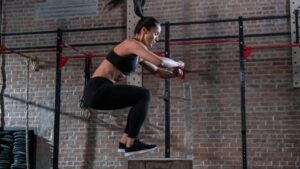
Dynamic box jump workout highlighting plyometric training for explosive power and agility. Box Jumps
- Why It’s Important: Box jumps are foundational for developing explosive lower-body power, balance, and coordination.
- Muscles Worked:
- Gluteus Maximus: Drives hip extension during the jump.
- Vastus Lateralis: Extends the knee joint.
- Soleus: Assists in ankle plantar flexion for the jump.
- How to Perform:
- Stand facing a sturdy box.
- Bend your knees and swing your arms backward for momentum.
- Explode upward, landing softly on the box with both feet.
- Step down carefully and repeat.
- Pro Tip: Start with a lower box and gradually increase height as you gain confidence.
Step-Up Jumps
- Why It’s Important: This unilateral exercise enhances single-leg power and balance, preparing for more dynamic plyometric movements.
- Muscles Worked:
- Rectus Femoris: Activates during the upward phase.
- Gluteus Medius: Stabilizes the pelvis during the movement.
- Gastrocnemius: Assists with pushing off the ground.
- How to Perform:
- Place one foot on a sturdy platform or step.
- Push through your front foot to jump explosively upward.
- Land softly on the same foot and repeat before switching sides.
- Pro Tip: Use your arms to generate momentum for higher jumps.
Broad Jumps
- Why It’s Important: Broad jumps build horizontal explosiveness, improving power for sports requiring sprinting and long jumps.
- Muscles Worked:
- Gluteus Maximus: Propels the body forward.
- Biceps Femoris: Controls knee flexion during the landing phase.
- Tibialis Anterior: Stabilizes the ankle during the landing.
- How to Perform:
- Stand with feet shoulder-width apart.
- Bend your knees and swing your arms backward.
- Explode forward as far as possible, landing softly with bent knees.
- Pro Tip: Focus on distance rather than height to maximize horizontal power.
Intermediate
Split Squat Jumps
- Why It’s Important: This exercise develops unilateral explosiveness, targeting the legs and improving balance.
- Muscles Worked:
- Vastus Medialis: Engages during knee extension.
- Gluteus Maximus: Powers hip extension.
- Soleus: Supports ankle stability during landing.
- How to Perform:
- Start in a split stance with one foot forward and the other backward.
- Lower into a lunge and explode upward, switching legs mid-air.
- Land softly and repeat.
- Pro Tip: Keep your torso upright to maintain balance.
Lateral Bounds
- Why It’s Important: Lateral bounds enhance side-to-side agility and explosiveness, critical for athletes in multidirectional sports.
- Muscles Worked:
- Gluteus Medius: Stabilizes the hip during lateral movement.
- Adductor Magnus: Controls leg positioning during landing.
- Peroneus Longus: Stabilizes the ankle during lateral shifts.
- How to Perform:
- Stand on one leg and jump laterally to the opposite side.
- Land softly on the other leg, absorbing the impact.
- Repeat, alternating sides.
- Pro Tip: Use your arms to maintain balance during each bound.
Depth Jumps
- Why It’s Important: Depth jumps focus on the stretch-shortening cycle, optimizing power output during jumps.
- Muscles Worked:
- Gluteus Maximus: Drives upward propulsion.
- Rectus Femoris: Assists with knee extension.
- Soleus: Absorbs impact during landing.
- How to Perform:
- Step off a platform and land softly on the ground.
- Immediately jump upward as high as possible.
- Reset and repeat.
- Pro Tip: Focus on minimizing ground contact time for better efficiency.
Advanced
Weighted Step-Up Jumps
- Why It’s Important: Adding resistance to step-up jumps increases intensity, building strength and power.
- Muscles Worked:
- Gluteus Maximus: Propels the upward motion.
- Vastus Lateralis: Extends the knee joint.
- Gastrocnemius: Assists with push-off.
- How to Perform:
- Hold dumbbells in both hands and place one foot on a platform.
- Push through your front foot to jump explosively.
- Land softly and repeat before switching legs.
- Pro Tip: Use light weights initially to focus on form.
Single-Leg Hops
- Why It’s Important: This exercise targets balance and single-leg strength, essential for sports requiring unilateral movements.
- Muscles Worked:
- Gluteus Medius: Stabilizes the hip.
- Vastus Medialis: Assists with knee stabilization.
- Soleus: Controls ankle stability during hops.
- How to Perform:
- Stand on one leg and hop forward, landing softly.
- Repeat for a set distance or number of repetitions before switching legs.
- Pro Tip: Keep your core engaged to prevent wobbling.
Barbell Squat Jumps
- Why It’s Important: Combines traditional squats with plyometric explosiveness for maximum power.
- Muscles Worked:
- Gluteus Maximus: Drives the jump upward.
- Vastus Intermedius: Powers knee extension.
- Rectus Femoris: Contributes to hip and knee movement.
- How to Perform:
- Hold a barbell on your back, as in a standard squat.
- Perform a deep squat and explode upward, lifting off the ground.
- Land softly and reset.
- Pro Tip: Use lighter weights to maintain control and avoid injury.
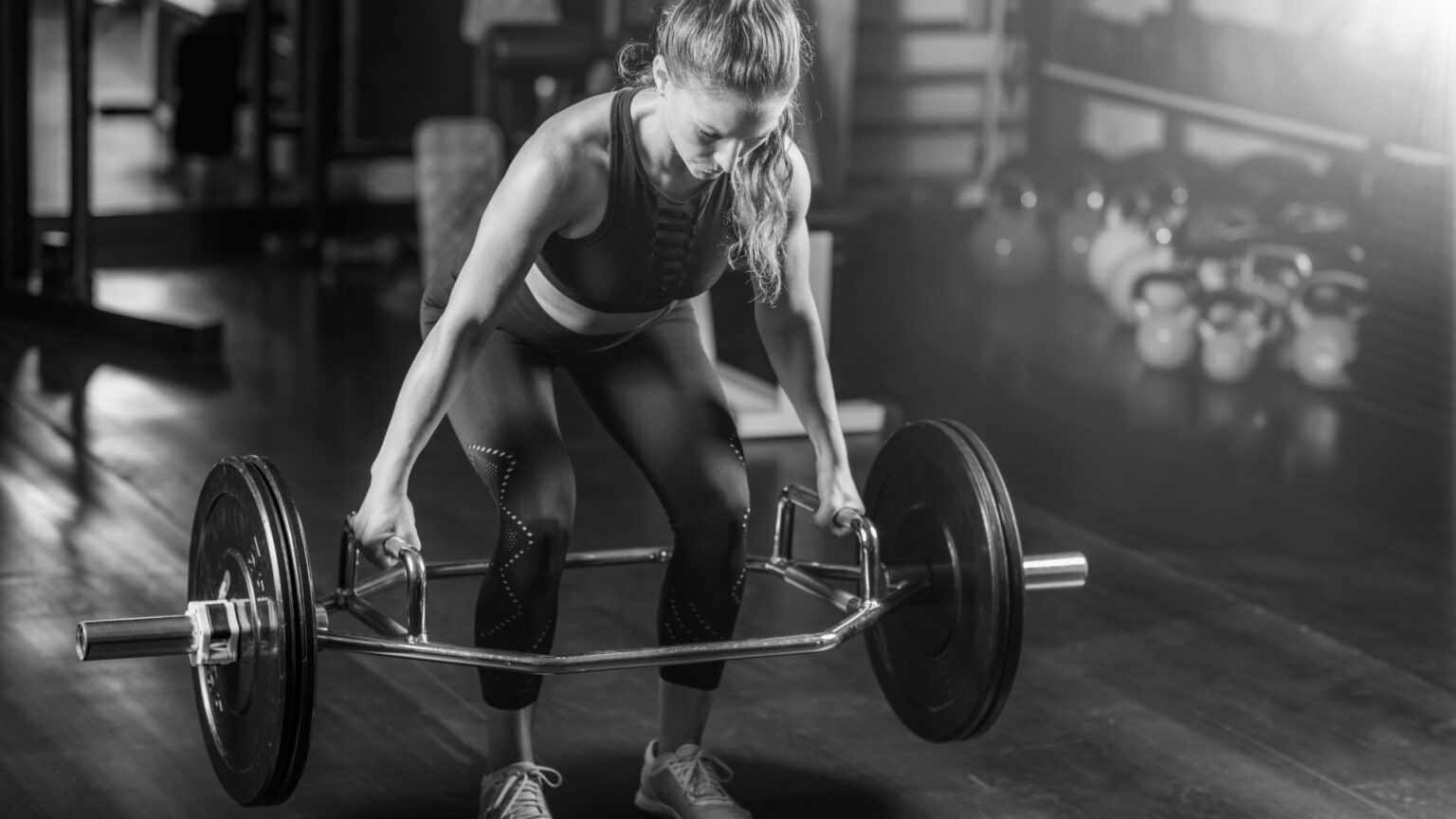
Inside the boxing gym strength training Comprehensive Table of Lower Body Plyometric Exercises
Exercise
Skill Level
Primary Muscles Worked
Why It’s Important
Box Jumps
Beginner
Gluteus Maximus, Vastus Lateralis, Soleus
Builds lower-body power and coordination
Step-Up Jumps
Beginner
Rectus Femoris, Gluteus Medius, Gastrocnemius
Enhances single-leg balance and power
Broad Jumps
Beginner
Gluteus Maximus, Biceps Femoris, Tibialis Anterior
Improves horizontal explosiveness
Split Squat Jumps
Intermediate
Vastus Medialis, Gluteus Maximus, Soleus
Develops unilateral explosiveness and balance
Lateral Bounds
Intermediate
Gluteus Medius, Adductor Magnus, Peroneus Longus
Enhances multidirectional agility
Depth Jumps
Intermediate
Gluteus Maximus, Rectus Femoris, Soleus
Optimizes power through the stretch-shortening cycle
Weighted Step-Up Jumps
Advanced
Gluteus Maximus, Vastus Lateralis, Gastrocnemius
Builds strength and explosiveness under load
Single-Leg Hops
Advanced
Gluteus Medius, Vastus Medialis, Soleus
Improves unilateral strength and balance
Barbell Squat Jumps
Advanced
Gluteus Maximus, Vastus Intermedius, Rectus Femoris
Combines squat strength with explosive power
In Closing…
Plyometric training is a dynamic and effective way to improve strength, speed, and overall athletic performance. By incorporating exercises like plyometric push-ups, depth jumps, and bounding, you can build a well-rounded routine that targets the SSC and enhances functional fitness. Whether you’re an athlete preparing for competition or someone seeking a more explosive workout, plyometrics offer unmatched benefits.
Plyometric exercises are a cornerstone of athletic training, offering unparalleled benefits in power, speed, and agility. By incorporating these dynamic movements into your fitness routine, you unlock your body’s potential to perform at its peak. From beginners mastering the basics of box jumps to advanced athletes tackling barbell squat jumps, plyometrics cater to all skill levels.
The science behind plyometrics, particularly the stretch-shortening cycle (SSC), underpins their effectiveness. This cycle allows muscles to store elastic energy during the eccentric phase and release it explosively during the concentric phase, optimizing power output. Understanding this principle helps athletes tailor their training to achieve specific goals, from improving sprint speed to enhancing vertical jump height.
Plyometric training also fosters neuromuscular coordination, ensuring that muscles fire in the correct sequence for maximum efficiency. Sports like basketball, soccer, and track events heavily rely on these attributes, making plyometric exercises indispensable. For fighters and martial artists, these movements enhance striking power and agility, delivering a competitive edge.
By progressively incorporating these exercises and prioritizing recovery, athletes of all levels can safely and effectively reap the rewards of plyometric training. Whether your aim is to improve athletic performance, boost endurance, or support fat loss, plyometric exercises provide a versatile and impactful solution.
FAQ Section
Plyometric exercises involve explosive movements designed to improve power, speed, and agility. They activate the stretch-shortening cycle (SSC), allowing muscles to store and release energy efficiently. This makes them invaluable for athletes and fitness enthusiasts aiming for peak performance.
You should have a strong foundation of strength, stability, and mobility. For example, you should be able to squat 1.5 times your body weight and perform consistent, controlled single-leg movements before attempting advanced plyometrics like barbell squat jumps.
Yes, plyometric exercises are highly effective for fat loss due to their high-intensity nature. They burn significant calories while building muscle, enhancing metabolism even after the workout. Plyometrics also improve cardiovascular health, making them a well-rounded fat-loss tool.
For most people, 2–3 times per week is ideal, allowing for recovery between sessions. Advanced athletes might integrate them more frequently but should monitor for signs of overtraining. Recovery is key to maintaining performance.
Ensure proper warm-up, use safe equipment, and focus on landing mechanics to prevent injury. Avoid overloading too soon and prioritize form over intensity. For beginners, starting with low-impact plyometrics is recommended.
Yes, but they should be modified for safety and individual fitness levels. Low-impact exercises, such as step-up jumps or mini hops, can provide similar benefits without placing undue stress on joints.
Choose shoes with good cushioning and support to absorb impact and prevent injuries. Cross-training shoes are often ideal for the lateral and dynamic movements involved in plyometrics.
Track metrics such as jump height, distance covered in broad jumps, or the number of repetitions performed. Regular testing can help identify improvements and areas for further development.
Resources
coachjohanncscs.com only uses primary research and scholarly studies as references over secondary sites. Other references are primarily from reputable social media accounts of experts only in the fields of health, nutrition, sports science, physiology, psychology, and physical therapy.
Ramirez-Campillo, R., & Garcia-Pinillos, F. (2021). Effects of plyometric jump training on electromyographic activity and its relationship to strength and jump performance in healthy trained and untrained populations. Journal of Strength and Conditioning Research. https://journals.lww.com/nsca-jscr/fulltext/2021/07000/Effects_of_Plyometric_Jump_Training_on.35.aspx
Chimera, N. J., Swanik, K. A., & Swanik, C. B. (2004). Effects of plyometric training on muscle-activation strategies and performance in female athletes. Journal of Athletic Training. https://pmc.ncbi.nlm.nih.gov/articles/PMC385258/
Ramírez-delaCruz, M., & Bravo-Sánchez, A. (2022). Effects of plyometric training on lower body muscle architecture, tendon structure, stiffness, and physical performance: A systematic review and meta-analysis. Sports Medicine – Open. https://link.springer.com/article/10.1186/s40798-022-00431-0
Markovic, G., & Mikulic, P. (2016). Neuro-musculoskeletal and performance adaptations to lower-extremity plyometric training. Sports Medicine. https://link.springer.com/article/10.1007/s40279-016-0634-6
McKinlay, B. J., Wallace, P., Dotan, R., & Long, D. (2020). Plyometric training and its role in neuromuscular development and injury prevention. Sports Health. https://app.scholarai.io/paper?paper_id=DOI:10.1177/1941738120938007&original_url=https%3A%2F%2Fjournals.sagepub.com%2Fdoi%2Fabs%2F10.1177%2F1941738120938007
Ramirez-Campillo, R., et al. (2022). Effects of long-term plyometric training on muscle power and biomechanics in athletes. Sports Medicine – Open. https://link.springer.com/article/10.1186/s40798-022-00550-8
Beattie, K., Kenny, I. C., Lyons, M., & Carson, B. P. (2016). Effects of plyometric training on sports performance: A systematic review and meta-analysis. Strength and Conditioning Journal. https://journals.lww.com/nsca-scj/fulltext/2016/02000/Effects_of_Plyometric_Training_on_Sports.5.aspx
-

Is treadmill a good warm up? | SAFE warmup FORM on the treadmill and Rope
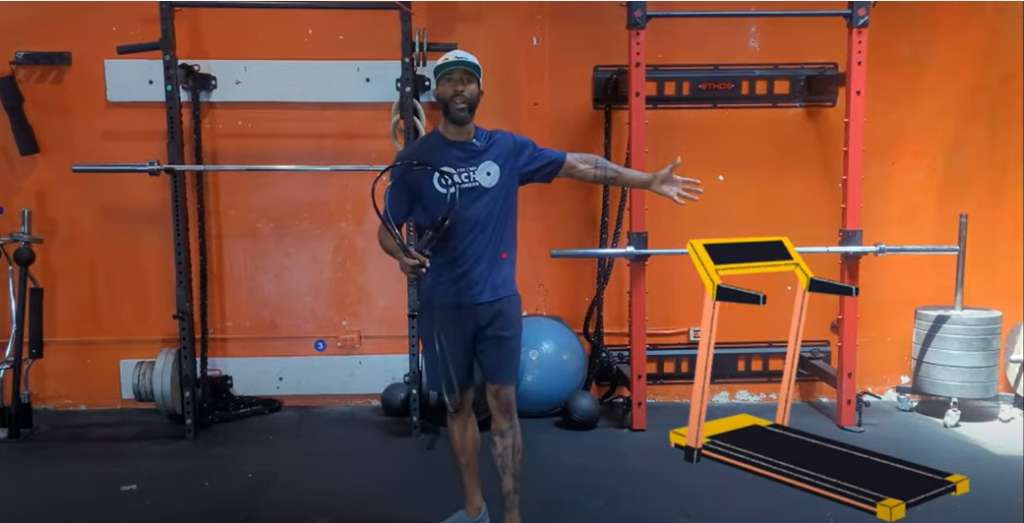
When we warm up on the treadmill we want to make sure a few things are in order.
👍SUBSCRIBE! https://www.youtube.com/c/Johannunderdogtraining?sub_confirmation=1
Once we have those things nailed down we adjust our foot position to maintain good leg control and for optimum stride. This doesn’t just apply to the treadmill we can do this to while jumping rope or doing any type of leg dominant impact warm up move.
_________________________ “FIGHTER CONDITIONING” Program
🟠🔵🟠🔵JOIN IN🟠🔵🟠🔵
Ego Killer PODCAST (REVIEW, earn a FREE GIFT ebook) *******
🔶https://egokillershow.com
FIGHTER CONDITIONING | Program Strength Training for the Fight Live Program Registration is Open 🔷https://coachjohanncscs.com/fighter/
FOLLOW on Insta:
🔶🔶https://www.instagram.com/johannunderdogtraining
🤝Hire Me:
https://lnk.bio/CoachJohannCSCS _______________________________________________________________________
#workoutroutines #treadmill #warmup
-

How to Sprint Faster: Hamstrings, Hips & Explosive Speed Training
How to Sprint Faster: The Role of Hamstrings, Hips, and the Stretch-Shortening Cycle

Uphill sprinting increases hamstring activation, forces stronger knee drive, and reinforces proper sprint posture. Training on inclines improves acceleration, leg stiffness, and explosive strength—all critical for fast-twitch sprint mechanics. Sprinting isn’t just about running fast—it’s about power, technique, and biomechanics. Whether you’re a fighter looking for better explosiveness, an athlete improving acceleration, or just someone wanting to increase speed, understanding which muscles drive sprinting is crucial.
Most people mistakenly believe the quads are the dominant muscles in sprinting. In reality, it’s the hamstrings and hips that generate forward propulsion. The quads act more as a braking mechanism rather than the main force behind sprinting. The key to maximizing sprint speed lies in optimizing muscle recruitment, refining mechanics, and training the stretch-shortening cycle (SSC).
This guide breaks down why hamstrings and hips are critical for sprinting, how to engage them for maximum speed, and the best exercises to develop powerful sprint mechanics.
The Science Behind Sprinting Mechanics
Sprinting is one of the most explosive, high-output movements the body can perform. To run at maximum velocity, the body must generate force, absorb impact, and transfer energy efficiently—all within fractions of a second.
Hamstrings & Hips: The True Powerhouses
The hamstrings and hips are responsible for:
- Generating horizontal force to propel you forward.
- Absorbing impact during ground contact.
- Controlling knee and hip extension to prevent deceleration.
- Driving hip flexion and extension for optimal stride length.
The quads, while active, function primarily as shock absorbers, helping control deceleration rather than producing forward propulsion. The real acceleration power comes from the posterior chain—the hamstrings, glutes, and hip flexors.
The Stretch-Shortening Cycle (SSC)
Sprint speed is directly tied to how well the body utilizes the stretch-shortening cycle (SSC). This cycle refers to the rapid stretch (eccentric phase) followed by an explosive contraction (concentric phase). Think of it like a rubber band—the more you stretch it, the harder it snaps back.
For sprinters, this means:
- More elasticity = More speed.
- Stronger pre-stretch = Greater force output.
- Faster contractions = Better acceleration.
Optimizing SSC reduces ground contact time, allowing the body to rebound quickly with each step.

Proper hamstring flexibility and mobility are crucial for sprint mechanics, reducing the risk of injury and enhancing performance. Sprint Technique: The Piston-Like Motion
Imagine your legs as pistons in an engine. The most efficient movement pattern occurs when the foot lands directly underneath the hips, not out in front. When the foot lands too far forward, it acts as a brake, slowing momentum.
Key Technical Points for Sprinting Faster
- Drive the knees high for better stride length.
- Land under the hips to avoid deceleration.
- Engage hamstrings and glutes for maximum force output.
- Maintain upright posture with a slight forward lean.
- Use arm drive to synchronize with leg movement.
Sprint drills should emphasize explosive knee drive, controlled foot placement, and full hip extension.
Exercises to Develop Sprint Power & Explosiveness
Sprinting speed is trainable. The right exercises enhance muscle activation, power output, and sprint efficiency. These movements focus on strengthening the hamstrings, glutes, and hip flexors while reinforcing proper mechanics.1. Hamstring-Driven Explosive Kettlebell Swings
Kettlebell swings mirror the hip-hinge mechanics of sprinting, making them one of the best exercises for improving hip extension and SSC.- How to Perform:
- Stand with feet shoulder-width apart, kettlebell between legs.
- Hinge at the hips, keeping the spine neutral.
- Explosively swing the kettlebell up using hamstrings and glutes.
- Control the descent and repeat.
- Why It Works:
- Strengthens hamstrings, glutes, and hip flexors.
- Improves explosiveness in sprinting mechanics.
- Enhances stretch-shortening cycle efficiency.
2. Single-Leg Romanian Deadlift (RDL)
This movement isolates hamstring engagement while reinforcing single-leg balance, a critical factor in sprinting.
How to Perform:
- Stand on one leg, holding a kettlebell in the opposite hand.
- Hinge at the hips, lowering the kettlebell while keeping a neutral spine.
- Squeeze the glutes and drive back up explosively.
Why It Works:
- Develops single-leg stability for sprint efficiency.
- Increases posterior chain activation for stronger strides.
- Strengthens hamstring resilience for injury prevention.
Progression: Perform with a slow eccentric phase to enhance SSC activation.
Bounding Drills for Sprint Mechanics
Bounding drills improve stride efficiency, force application, and leg stiffness for more powerful sprints.
How to Perform:
- Start with high-knee skips, focusing on explosive takeoff.
- Extend each stride with maximum force.
- Land softly, absorbing impact through the hamstrings.
Why It Works:
- Reinforces proper foot placement under the hips.
- Increases hamstring activation in full stride cycles.
- Enhances elastic energy return for faster acceleration.
Progression: Add resistance bands for greater force output.
4. Sled Sprints for Maximum Acceleration
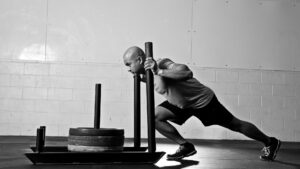
Proper hamstring flexibility and mobility are crucial for sprint mechanics, reducing the risk of injury and enhancing performance. Sled sprints develop lower-body power and sprint drive, simulating resisted acceleration.
How to Perform:
- Load a sled with moderate resistance.
- Sprint forward, maintaining low body positioning.
- Keep steps short and powerful.
Why It Works:
- Overloads the sprint pattern for increased force production.
- Develops glute and hamstring drive for acceleration.
- Strengthens hip flexors for longer stride length.
Progression: Gradually reduce sled weight to transition into bodyweight sprinting.
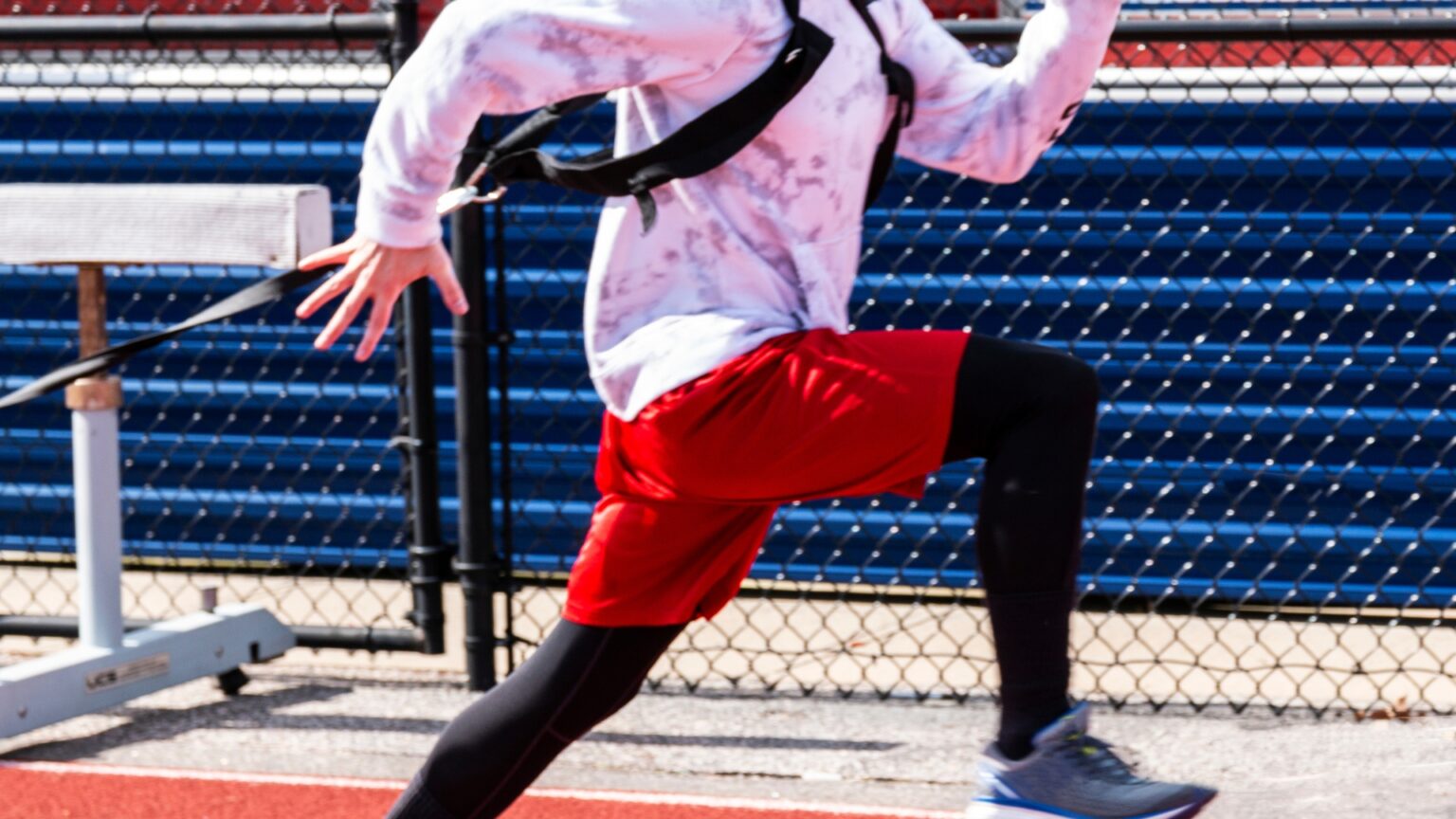
Resisted sprinting with a harness builds explosive power and strengthens the posterior chain for maximum acceleration. Common Sprinting Mistakes & How to Fix Them
Even trained athletes make small technical errors that reduce sprint speed. Here are the top mistakes and how to correct them.
Mistake Why It Slows You Down How to Fix It Overstriding Increases ground contact time, reducing efficiency. Land under the hips to maintain momentum. Lack of hip engagement Limits stride length and power output. Strengthen hip flexors with sled sprints and bounding drills. Weak hamstrings Increases injury risk and reduces acceleration. Incorporate Romanian deadlifts & swings. In Closing…
Sprinting is not just about running fast; it’s about training your body to move with precision, power, and efficiency. While many people focus on quad strength, the real key to acceleration and top speed lies in the hamstrings and hips. These muscles drive forward propulsion, stabilize the lower body, and enable explosive movement patterns that separate elite sprinters from the rest.
If you want to sprint faster, your focus should be on posterior chain activation, sprint mechanics, and the stretch-shortening cycle. Mastering these elements ensures every stride is powerful, efficient, and biomechanically sound.
Key Takeaways for Faster Sprinting
- Hamstrings and hips dominate sprint mechanics, not the quads.
- Proper foot placement under the hips prevents unnecessary braking.
- The stretch-shortening cycle (SSC) creates explosive force and acceleration.
- Sprinting drills and strength exercises enhance stride efficiency and speed.
- Single-leg stability, plyometrics, and sled sprints help reinforce optimal movement patterns.
By applying these techniques and progressive overload principles, you’ll increase sprinting efficiency and prevent injury. Whether you’re a fighter, track athlete, or weekend warrior, refining your mechanics, explosiveness, and posterior chain strength will lead to a dramatic improvement in your sprint speed and acceleration. Sprinting is a skill—train it with the same precision and intent as any other athletic movement.
FAQ Section
The hamstrings are responsible for hip extension and knee flexion, which generate forward propulsion. The quads, on the other hand, primarily control deceleration and absorb impact rather than actively pushing the body forward.
The SSC allows muscles to store and release elastic energy, much like a stretched rubber band snapping back. This enhances stride efficiency, power output, and acceleration by reducing ground contact time and maximizing force transfer.
Kettlebell swings, Romanian deadlifts, sled sprints, and bounding drills are all highly effective for developing hamstring strength, explosive power, and sprint mechanics.
Focus on landing under your hips instead of reaching forward with each step. Sprint drills like high-knee sprints, A-skips, and resisted sled sprints reinforce proper foot placement and reduce unnecessary deceleration.
Sprinting activates the hamstrings intensely, but strength training is necessary to build resilience, power, and injury resistance. Combining sprints with weightlifting and plyometrics creates the best results.
Resources
coachjohanncscs.com only uses primary research and scholarly studies as references over secondary sites. Other references are primarily from reputable social media accounts of experts only in the fields of health, nutrition, sports science, physiology, psychology, and physical therapy.
Heiderscheit, B. C., Chumanov, E. S., & Thelen, D. G. (2011). Hamstring musculotendon dynamics during stance and swing phases of high-speed running. Medicine & Science in Sports & Exercise.
https://www.ncbi.nlm.nih.gov/pmc/articles/PMC3057086/Haugen, T., McGhie, D., & Ettema, G. (2019). Sprint running: from fundamental mechanics to practice—a review. European Journal of Applied Physiology.
https://link.springer.com/article/10.1007/s00421-019-04139-0Huygaerts, S., Cos, F., Cohen, D. D., & Calleja-González, J. (2020). Mechanisms of hamstring strain injury: interactions between fatigue, muscle activation, and function. Sports.
https://www.mdpi.com/2075-4663/8/5/65/pdfNagano, Y., Higashihara, A., & Takahashi, K. (2014). Mechanics of the muscles crossing the hip joint during sprint running. Journal of Sports Sciences.
https://www.tandfonline.com/doi/abs/10.1080/02640414.2014.915423Lichtenstein, E., Faude, O., & Jorge, A. (2024). Muscle Activity and Kinematics During Three Hamstring Strengthening Exercises Compared to Sprinting: A Cross-Sectional Study. International Journal of Sports Science.
https://www.ncbi.nlm.nih.gov/pmc/articles/PMC11065773/Schache, A. G., Dorn, T. W., & Blanch, P. D. (2012). Mechanics of the human hamstring muscles during sprinting. Medicine & Science in Sports & Exercise.
http://www.timzone.net/papers/Mechanics_of_the_human_hamstring_muscles_during_sprinting.pdf
